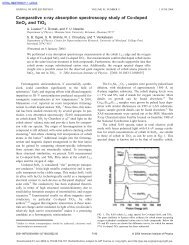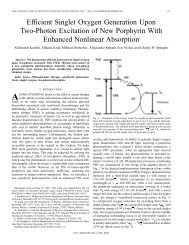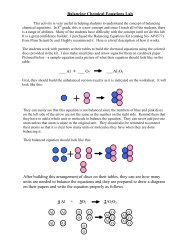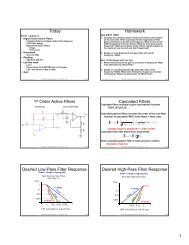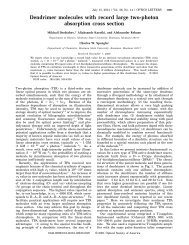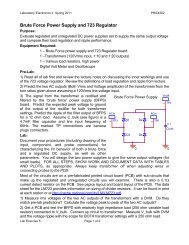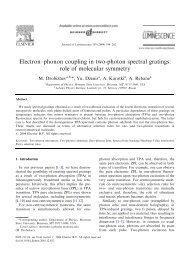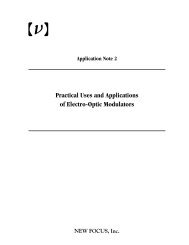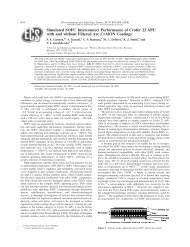Defects in inorganic photorefractive materials and their investigations
Defects in inorganic photorefractive materials and their investigations
Defects in inorganic photorefractive materials and their investigations
Create successful ePaper yourself
Turn your PDF publications into a flip-book with our unique Google optimized e-Paper software.
20 B. Briat et al.<br />
In addition, the charge transfer processes caus<strong>in</strong>g the photochromic changes<br />
have been clarified. They are summarized by the scheme <strong>in</strong> Fig. 9a: two ’3-<br />
valence systems’, conta<strong>in</strong><strong>in</strong>g three charge states of Rh <strong>and</strong> of Fe, resp., are<br />
coupled to each other via the valence b<strong>and</strong>, with which both systems can exchange<br />
holes. This figure also symbolizes the optical <strong>and</strong> thermal processes,<br />
by which valence b<strong>and</strong> electrons are excited to the levels, <strong>and</strong> <strong>their</strong> recomb<strong>in</strong>ation<br />
with holes <strong>in</strong> the valence b<strong>and</strong>. The parameters attached to the arrows,<br />
express<strong>in</strong>g the rates by which these processes occur, are expla<strong>in</strong>ed <strong>in</strong> the figure<br />
caption. The <strong>in</strong>dicated scheme can be cast <strong>in</strong>to rate equations [106] for the<br />
populations of the various occurr<strong>in</strong>g charge states, similarly to those given by<br />
Kukhtarev et al. [109] for the one-center model.<br />
After the qualitative step, <strong>in</strong>dicat<strong>in</strong>g the defects <strong>in</strong>volved <strong>and</strong> the charge<br />
transfer ways connect<strong>in</strong>g them, as summarized before, it is desirable to obta<strong>in</strong><br />
also quantitative <strong>in</strong>formation on the <strong>photorefractive</strong> performance of such a system.<br />
This means first: What are the values of the parameters <strong>in</strong> Fig. 9a? And,<br />
what is the size of the space charge fields E SC which can be reached with such<br />
a system? If the photoionized charges are transported only by diffusion, <strong>their</strong><br />
dependence on the grat<strong>in</strong>g wavevector k is given by: E SC ∝ k/(1+k 2 /ko) 2 with<br />
ko 2 ∝ N eff [109], the effective trap density, with known parameters of proportionality.<br />
E SC thus is fixed, once N eff has been determ<strong>in</strong>ed. For a ’3 - valence’<br />
system based on Rh, as an example, N eff depends on the defect densities <strong>in</strong><br />
the follow<strong>in</strong>g way [103]: Neff Rh = Rh tot − Rh 4+ (I) − (1/Rh tot )(Rh 3+ − Rh 5+ ) 2<br />
[105]. Here Rh 4+ (I) is the concentration of Rh 4+ under illum<strong>in</strong>ation with <strong>in</strong>tensity<br />
I; the other specified densities are those <strong>in</strong> the equilibrated dark state.<br />
An analogous relation holds for the Fe ’3-valence’ subsystem, both lead<strong>in</strong>g to<br />
N eff = Neff Rh + N eff Fe . In order to determ<strong>in</strong>e E SC, the densities of the identified<br />
defects must be known quantitatively (see [105, 106]). For the EPR-active<br />
charge states the concentrations are easily determ<strong>in</strong>ed from the <strong>in</strong>tensity of<br />
the correspond<strong>in</strong>g EPR signals. Indirectly, this is also possible for the EPRsilent<br />
charge states [105, 106]. This <strong>in</strong>formation can be transformed <strong>in</strong>to the<br />
absorption cross-sections S(E) (Fig. 9d) of the defects tak<strong>in</strong>g part <strong>in</strong> the<br />
transfers. These quantities allow to obta<strong>in</strong> the density N of a defect at room<br />
temperature, when only its absorption b<strong>and</strong> can be detected, s<strong>in</strong>ce the absorption<br />
function α(E) is given by: α(E) =NS(E). On this basis the defect<br />
densities <strong>in</strong> BT crystals conta<strong>in</strong><strong>in</strong>g various Rh dop<strong>in</strong>gs have been determ<strong>in</strong>ed<br />
(Table 2); <strong>in</strong> all cases the effective trap density, N eff , a measure of the space<br />
charge fields, could be well predicted (see Table 2). By <strong>in</strong>vestigat<strong>in</strong>g the timedependence<br />
of the absorption changes under chang<strong>in</strong>g illum<strong>in</strong>ation, we were<br />
furthermore able to obta<strong>in</strong> all the parameters occurr<strong>in</strong>g <strong>in</strong> Fig. 9a, necessary<br />
to describe the k<strong>in</strong>etic behavior of the system.<br />
The advantage of the approach essentially consists <strong>in</strong> the fact that the<br />
densities of the six defects appear<strong>in</strong>g <strong>in</strong> Fig. 9a can be determ<strong>in</strong>ed; previously<br />
[103, 104] the evaluations had to rely on only one number represent<strong>in</strong>g a concentration,<br />
the experimentally determ<strong>in</strong>ed trap density, N eff . In the present<br />
method this is not an <strong>in</strong>put parameter but can be predicted from the analy-





